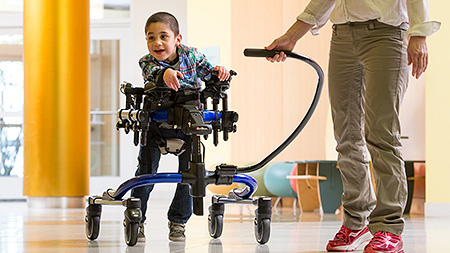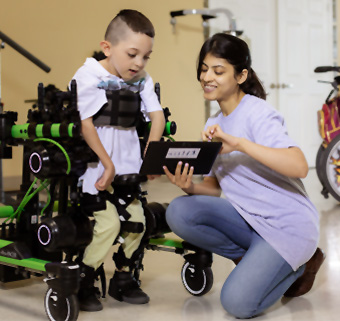Why Dynamic Gait Training?
A Closer Look at Improving Mobility and Gait Patterns
| October 2015
 Walking is a complex function and dynamic mobility features are important in gait training equipment as they assist in creating natural and more typical gait patterns. When we talk about dynamic gait training, we are appreciating the often unobserved but significant shifts of the body (as indicated by its center of gravity) particularly in the vertical and lateral directions for energy efficient and effortless walking to occur.
Walking is a complex function and dynamic mobility features are important in gait training equipment as they assist in creating natural and more typical gait patterns. When we talk about dynamic gait training, we are appreciating the often unobserved but significant shifts of the body (as indicated by its center of gravity) particularly in the vertical and lateral directions for energy efficient and effortless walking to occur.
Vertical Displacement
In the vertical direction, the center of gravity (located in the pelvis) moves up and down following a smooth sinusoidal path with the highest point at mid-stance which adds height to help clear the contralateral swing leg as it moves through to take a step. The average vertical displacement of the center of gravity during stepping is roughly 5 cm. This up and down motion also contributes to the body’s ability to store and release energy for efficiency and highest performance levels.
Body Weight Support
Additionally, there is the concept of body-weight support (BWS) during gait. In a static system, the straps of the pelvic support are set to a fixed length. During ambulation as a patient raises and lowers their body as in stepping, the straps alternately go from slack to taut. The constancy of body-weight unloading is not guaranteed and this negatively affects gait pattern by issuing destabilizing forces to the patient.
In a dynamic system the amount of vertical unloading is kept constant while still allowing the center of gravity to move through its curve. Research shows that dynamic BWS creates more natural ground-reaction forces and gait characteristics (Frey, 2006).
Weight-Shifting
Lateral displacement of the center of gravity also follows a smooth sinusoidal curve with an average displacement of two inches. In gait this is referred to as weight-shifting. During the stance phase of gait, the center of gravity moves laterally towards the planted limb making it easier to swing the contralateral limb through to take a step.
 Dynamic Gait Training Equipment
Dynamic Gait Training Equipment
Dynamic gait training is best achieved with a well-positioned pelvis. Efforts of the client to ambulate can then be assisted by the body-weight support of the gait trainer with its dynamic vertical and lateral movements to achieve a more normal gait pattern and easier stepping. Specialized equipment, like the Rifton Pacer, helps achieve proper pelvis position and provides the body-weight support needed for a more natural gait pattern and easier stepping.
References
Initial studies in dynamic movement were done in seating (Hahn, 2009; Cimolin 2009). These studies, although small, show trends that with dynamic features in seating systems clients exhibited better ROM, normalization of tone, better positioning and improved standing and walking.
1. Hahn M, Simkins S, Gardner J, et al. A dynamic seating system for children with cerebral palsy. J Musculoskeletal Research. 2009; 12 (1): 21-30.
2. Cimolin V, Piccinini L, Avellis M, et al. 3D-quantitative evaluation of a rigid seating system and dynamic seating system using 3D movement analysis in individuals with dystonic tetraparesis. Disabil Rehabil Assist Technol. 2009; 4(6):422-28.
Research on dynamic gait training is limited. But so far, all the studies indicate positive results.
Paleg and Livingstone in their 2015 research study, a systematic review of the evidence available on gait training for children with disabilities, noted that because the research on dynamic seating is positive, this may certainly have implications that dynamic gait trainers may be beneficial for children with spasticity and dystonia.
3. Paleg G, Livingstone R. Outcomes of gait trainer use in home and school settings for children with motor impairments: A systematic review. Clin Rehabil. 2015; January 30. [Epub ahead of print].
In a small study (n=10, abstract only) by Sheryl Low in 2009 a static gait trainer was compared to a dynamic gait trainer. There was statistically significant increased velocity, cadence, timed functional walk and quality of gait with the dynamic gait trainer as compared to the static one.
4. Low S, Westcott S. A comparison of two support walkers on the gait parameters of children with cerebral palsy- abstract. Dev Med Child Neurol. 2009;51:62.
Frey and colleagues in 2006 set the groundwork for dynamic body-weight support showing that constant and vertical unloading of the body during gait provides near-normal ground-reaction patterns compared to static unloading systems. This was expanded upon by Hidler et al in 2011 when looking at the ZeroG and its dynamic body-weight support features for improving function and gait.
Otherwise body-weight supported gait training is well-supported in the literature (too many studies to list here).
5. Hidler J, Brennan B, Black I, Nichols D, Brady K, Nef T. ZeroG: Overground gait and balance training system. J Rehabil Res Dev. 2011;48(4): 287-98.
6. Frey M, Colombo G, Vaglio M, Bucher R, Jorg M, Riener R. A novel mechatronic body weight support system. IEEE Trans Neural Syst Rehabil Eng. 2006;14(3):311-21.




